Translation Notes: [Commie] Shinsekai Yori 01 This entry was posted by Nanu.
I am the translator involved in the Commie’s release of the Shinsekai Yori Ep.1.
In Shinsekai, there are many words that are made up especially for the Shinsekai Yori, and therefore I thought some follow-ups on them would be helpful for those curious to know the details on them.
However, there are some terms that are tightly related with how the hidden details of the story, and explaining them in full details would spoil the whole show.
So, here, I would like to limit my notes as to what each word means in Japanese and some of the references made in the show.
(Also, there are some apologies and corrections I have to make for the Commie’s release.)
I would be really grateful if you can disagree with what I have here and tell me about that with a ground to support the claim. If I made mistakes, and I am aware that I’m far from being perfect, I would like to improve upon them. For the most of the mistakes being mentioned in the translation review on this blog, I will not mention them here as that would be redundant of the previous post on the translations.
(For my references, I used a copy of the book published by Koudansha, and the page numbers I put in the notes refers to those in that book. It’s an interesting SF novel, and if you can read Japanese, it’s worth taking time to read it once. It’s only 953 pages too.)
The order in which I organized the list of words is, Romanji (Japanese)/ How I translated in Commie’s
The Name of the Station at the Scene in the Beginning
It’s probably Minamiasagaya(南阿佐ケ谷). It’s a part of Tokyo Metro, which is one of the subway systems in Tokyo, so it probably is what I think it is. (By the way, the Tokyo Metro(東京メトロ) was written in the sign in the show as Tokyo Meroto (Tokyo Meroto). It made me giggle.{This is not really a TL note, but whatever.})
The Song at the Flash Back Scenes
It’s a song from “The Symphony No. 9 in E Minor From the New World, Op. 95, B. 178,” composed by Antonín Dvořák in 1893.
Yes, it’s called “New World Symphony” as well. How fitting to the story called, “From the New World.”
It is also a popular song in Japan (called as “ieji (家路),” which literally means “on the way to home” or “Going Home.”) for the music in closing of supermarkets and school to prompt people to leave the building. I’ve listen to them when I was small and living in Japan, so it’s true, at least 10 years ago. I don’t know if people are still playing this song for that purpose though, but I assume they do.
I guess the translation for the name of the song could be that of English, but that would not mean what’s stressed by the song in this scene, which is to go back home.
Nekodamashi(ネコダマシ)/ Faze Cat
If you translate it literally, it is an act of slapping hands in front of the opponent’s face to confuse him, which is clearly not the case. (There is a move in Japanese version of pokemon with this name too.) But in this case, it’s a noun with the nuance of “tricking” cat, and I found “faze” fits nicely with “cat,” so I went on with it.
In the story, it is portrayed as a giant cat-like creature that would chase after children in the shadow. It is described in the book as the following. “It looks like a giant cat with height of an adult human. Its face is just like that of a cat, but it has unusually long limbs. It chases a child like a shadow, and when there are no one else around, it puts a front leg onto a child’s shoulder. The child would then be paralyzed as if it casted hypnosis on him. After that it would bite into the child’s neck with a mouth that opens 180 degrees and drag him somewhere, leaving no trace of both the monster and the child.”(summarized from the book.) As Saki’s mother dismisses it as a silly rumor among children, it probably is just an imaginary being.
(Pg. 33-34)
Minoshiro (ミノシロ)/ White Slug
This one is hard because even in the book, the origin of its spelling is debated as well. The fact that the word is written in katakana makes it difficult to translate into a definite word in English.
There are several hypothesis listed in the book.
1) It originated from its appearance that looks like wearing “minoshiro-goromo (蓑白衣)”, which is supposed be some kind of a cloth, but no one in the book knows how it look like.
2) minoshiro (蓑白)= mino (蓑) is straw cape and combined with shiro (白), white.
3) minoshiro (霊の代) =” Bowl for Spirit.” Because it is believed to be an object to which a spirit is drawn or summoned
4) minoshiro(海の社) = “Shrine of Sea” because it usually lives on land, but it goes back to ocean to lay eggs.
5) minoshiro (美濃城)= “Mino Castle” because it resembled a golden dolphin on the castle, which was proven wrong later because the golden dolphin was not placed on Mino Castle but Nagoya Castle.
6) minoshiro (三幅四郎) = “108 cm Shirou” from an urban legend of a man named Shirou, who supposedly angered white snake and was turned into minoshiro.
So… yeah, I don’t really know what to translate it really. Maybe it was better left untranslated as “minoshiro.”
My choice of “White Slug” came from the description in the book, referring it as resembling a sea slug, but it doesn’t sound right now that I think about it.
Anyway, other descriptions of minoshiro (ミノシロ) are more interesting. It is mentioned in the book that there is no record of minoshiro (ミノシロ) in the books from 1000 years ago and later, which means minoshiro started to appear on earth around within few hundred years from the time of the story, although it is kind of a sudden event. It seems like that their predecessors are family of sea slug. Minoshiro (ミノシロ) is around 10 cm to 1m in length, having Y shaped antenna on its forehead. Because its eyes are buried in its skin, it seems to only detect brightness. It has many legs like a caterpillar. It eats almost anything and store poison within its body. It changes its body color according to what it just ate. It attacks enemies with its antenna, but it never attacks human…etc. etc.
I’m sure it will come out later in the series.
(pp.124-128)
Episode Title: Wakaba no Kisetsu (若葉の季節)/ Season of Fallen Leaves
It was same as the Chapter 1 title in the book, and it’s “Season of Fresh Leaves.” Yes I made mistake.
Such a big fail. I apologize.
How did I mess up? Well, my excuse would be…because the kanji in the title log was so broken (for a style of calligraphy) that I mistook it not as “waka(若), ” which means “young,” but as “Ochi (落),” which means “to fall.”
Yeah, but really, I should have looked back at the book once I finished translating them.
Hacchou-jime (八丁標)/ Boundary-Rope
This was easily the most difficult ones to translate out of the all terms in the first episode.
I tried to find out the origin of the word, but I failed at it. I don’t know if it actually refers to something related to Shinto tradition, but I assume it’s just a made-up word.
As described in the book, it’s a rope with many pieces of paper hanging from it. This concept of using special kind of rope to surround an area to form a barrier comes mainly from the Shintoism practice. In Shinto, one of the key elements of its beliefs is the avoidance of all things impure or soiled. Touching blood would make you soiled, and killing of all things living would make you soiled etc… Also it is believed that good spirits, if worshipped in right manner, would protect you protect you with mystical powers.
As far as I concern, it could be left untranslated or translated as taboo-rope or boundary-rope. All of them are valid choice, and we happened to choose the boundary-rope.
(p. 14)
Syukurei (祝霊)/ Blessing
Literal translation would be “Blessing Spirit” or “Spirit of Blessing.” I thought blessing is a vague and formless enough being that putting “spirit” is redundant. But if you think it could be better to go with “Blessing Spirit,” I would agree with that too.
In the story, it is regarded as a sign of children being matured. The poltergeist-like phenomena that happened to Saki was the manifestation of her jyuryoku (呪力). Although it was not depicted in the show, after having this sign, children would meet with people from the Education Board, get on to a window-less boat, and sent to the temple called Syoujou-ji (清浄寺) (this one is the correctly spelling, btw), where each of them would take part of an initiation ritual, which was depicted in the show. After the ritual, the children would then start to attend different school with curriculum focused on learning how to control their jyuryoku. Thus, it basically marks the time when a child can use the jyuryoku.
Waki-En (和貴園)/ Waki Academy
The name comes from an old phrase “Wa wo motte tattoshi to nasu”(和を以って貴しと為す), which basically means, “harmony is to be valued,” and the first two kanjis are used for the name of the school. Yes, it seems that harmony is of the utmost importance in the society.
So, it could be “Harmony Valuing Academy” if translating it literally, but I just went with “Waki Academy,” since the name of the school is not really important other than the fact I stated above.
By the way, there two other schools like “Waki-En (和貴園),” which are “Yuuai-En (友愛園) ” and “Yokuiku-En (徳育園),” one referring friendship and love and other referring value of education.
Zennjin Gakkyuu (全人学級)/ Apotheosis Class
It’s a tough one as well. Zennjin Gakkyuu (全人学級) means, in literal translation…actually I’m not entirely sure which meaning of Zennjin (全人) it refers to. It can mean all-man, or it can also mean saint or a perfect being. Considering the implication of training children with the telekinesis power, I assumed it’s the latter. I couldn’t find a reference to its origin in the book, so I will have to look more into it as I go along once again.
Jyuryoku (呪力)/ Cursed Power
It was a difficult one to translate, but, thinking back, I may have made this more complicated than it should have.
The literal translation would be either “Magic Power” or “Cursed Power.” The word 呪 has two meanings. One meaning for it is a magic, an act to cast a mystical power. But, compared to another word, mahou (魔法), which we often hear in other animes as the word for “magic,” jyujyutsu(呪術) is considered to refer to more primitive form of magic, which developed in the early stage of human civilization. So, jyujyutsu would refer to something like shamanism.
Another meaning is as a “curse” or an act of cursing others. “norou /呪う” is “to curse” in Japanese, for example.
The main reason I chose “Cursed Power” for jyuryoku(呪力) is because of the scene at the very beginning of the first episode. The name of the telekinesis-power must have been coined after what happened there, and also there are also some evidences in the book that suggest negative connotation to the power.
For the time being, I shall not go deeply into the discussion of this term. For now, let us just consider it as an important power that people in the community can exercise.
(pg. 152-171)
Hitogata (人形)/ Human-Shaped Paper
From the kanji, it can be translated as a “doll” or from the pronunciation, “humanoid.”
I put it as “human-shaped paper,” because I thought that would make it clear to viewers.
This is also a clear Shinto reference too. The paper figurine is used for variety of purposes in Shinso rituals. But you may wonder “what are Shinto things doing at Buddhist temple?” but it’s really simple. Historically in Japan, Shinto and Buddhism coexisted in the early periods, and remnants of the mixed traditions are still present in modern Japanese culture.
The White Mask
It’s called “Mask of Innocence” (無垢の面), I think, but I’m sure it will come up later in the story. If I’m right about the name of the mask, it’s a mask used for a seasonal festival they have at the town, and the line would be “kegare wa uchi ni” (穢れはうちに), which I had it as “Sin is within us.” But then, the line had so much echo, I couldn’t make sense out of it, so it may not be true. Don’t worry about this for now. Just think something creepy is going on there.
(pg. 63)
Fukuroushi (袋牛)/ Sac Cow
Literal translation would be “Sac Cow,” just like we put in for Commie’s release. It’s a cow, with a sac/bag on it.
It’s one of the examples of animals that are similar to what we know yet evolved into something weird in the 1000 years that passed since the apparent devastation of the previous civilization. There will be many more weird animals to come. I’m personally really excited to see how the show would design them.
(pp. 67-69)
Akki (悪鬼)/ Akki
In literal translation, it would be “Evil Demon/ Ogre.”It appears in a tale told in the story as a being that lives outside of the town and would bring devastation to the community if led inside of the town. In the show, Maria (the girl with red hair) was asked to read aloud the story in the class. The version read in the show actually cut out details of the whole story, although it covers the important details. Basically it was about teaching children not to go out of the boundary of the town and the spirit of self-sacrifice for the sake of community. Actually there is more to it, but that’s something to be told later.
(pg. 17-20)
Gouma (業魔)/ Gouki (!?)
Yes, I failed hard on this. It was my typo and nothing else, not even a translation error! (Two things ending both in “ki” sounded better, so I got carried away with the idea…)
I sincerely apologize for the confusion.
Anyway, in literal translation, it would be “Sin Demon.” From the preview, it seems it would be explained in the second episode, so I will not touch much into this for now. But know that Akki and Gouma are usually referred together in most times as the beings in the tales for children.
(pg. 21-22)
Fujyouneko (不浄猫) / Filth Cat
It’s literal translation would be “Filth Cat,” like we had it in Commie’s release.
“Fujou (不浄)” here refers to the soiled-ness and dirtiness referred in the Shino reference.
So, it could be better as “Soiled Cat,” which I now find it much more fitting. (Why didn’t I come up with this earlier…?)
You may wonder, why Saki’s mother refers to “nekodamashi(ネコダマシ),” as “fujyouneko (不浄猫),” but you can only speculate at this point.
(pg. 44)
That’s it for the major things I wanted to cover on this episode.
Feel free to disagree with any of the things I said on the notes. I’d like to hear what you have to say.
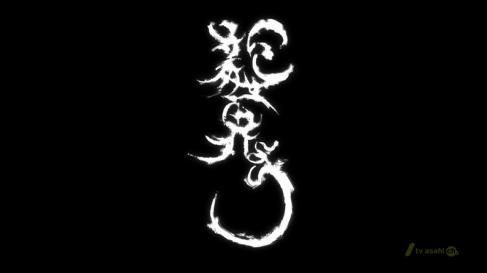
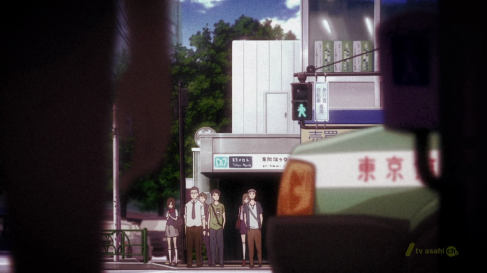
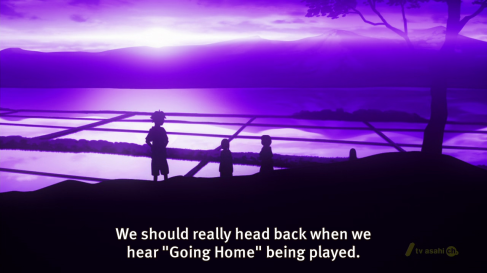
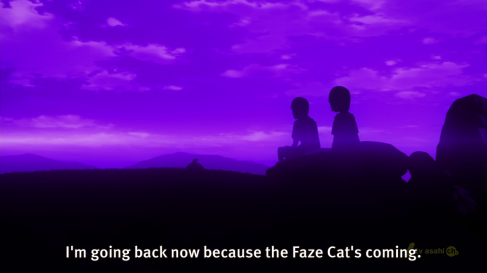
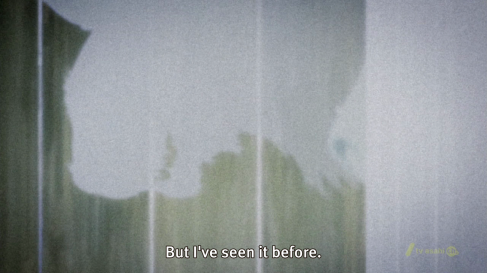

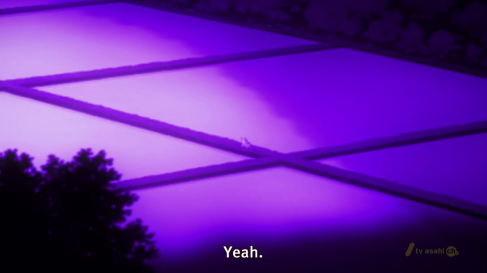
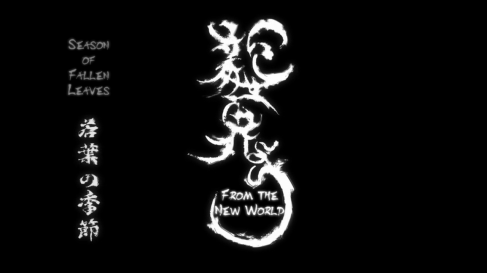
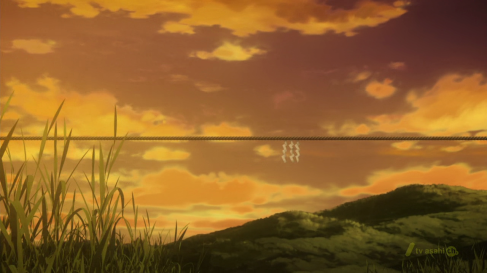
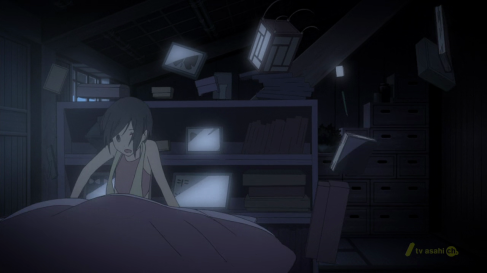
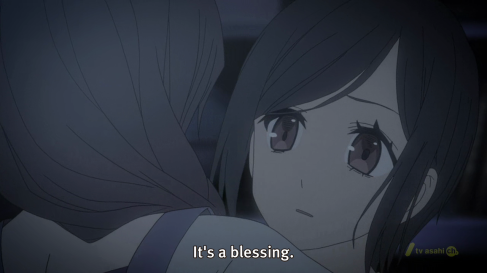
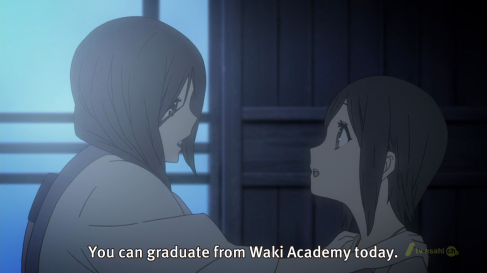
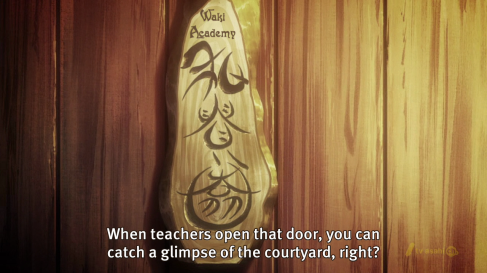
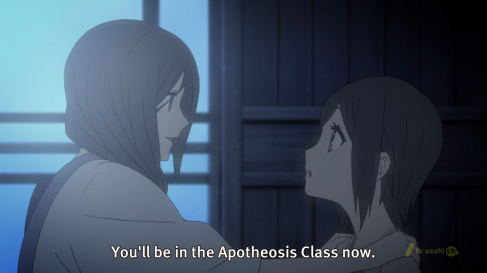
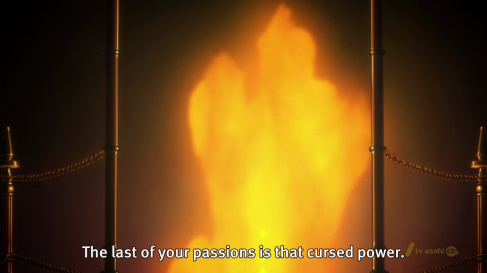
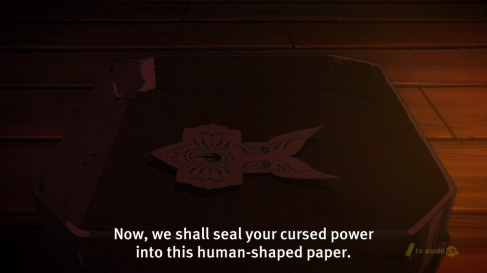
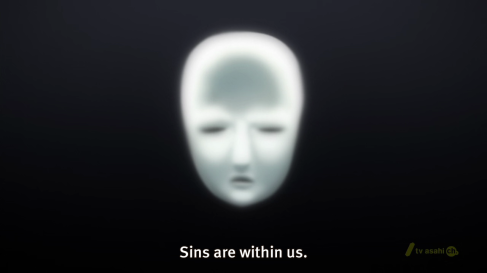
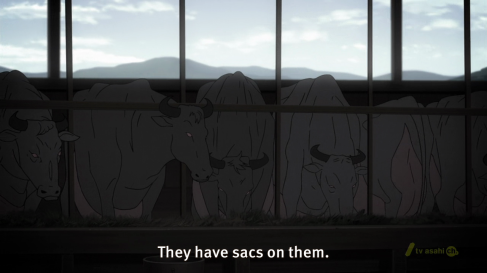
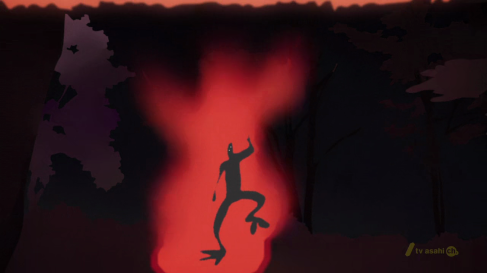
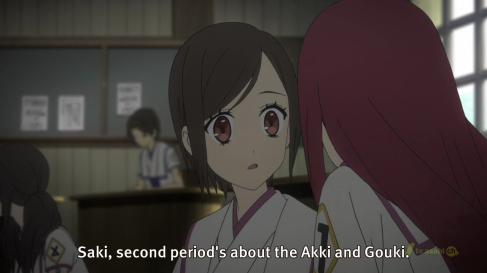
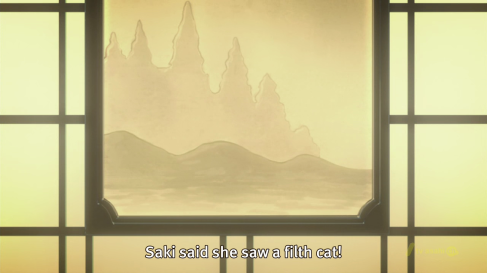
Pingback: Shinsekai Yori From the New World – 1, KC 13 END « Commie Subs | Sub Everything™
Thanks for these notes!
For Hacchoujime though, I would say that I think it’s better left untranslated. I believe it’s used as a name for the barrier.
While they used it with no explanation early in the episode, during the story reading in class, there was a phrase, “Haccchoujime no shimenawa” so I believe Hacchoujime is the name for the shimenawa (http://en.wikipedia.org/wiki/Shimenawa). So, I think Shimenawa can be translated and Hacchoujime can be left untranslated as a name. Then maybe the meaning of the kanji used in the name can be noted separately… It’s probably not really a big deal to just call it a rope barrier (I haven’t read the books), but since it has a name, I just think it’s good to leave it having one.
As for the significance of the name, I tried to look for any connections to Buddhism/Shinto but pretty much, I only found that 8 is a significant number in Buddhism (http://en.wikipedia.org/wiki/8_(number)#In_religion). Adding this to the meanings of the rest of the kanji makes for a vague meaning I guess… Something like 8 town signposts perhaps? But I hardly know anything about Buddhism, so…yeah. I’m just sharing what I found in trying to make sense of the name as well. 🙂
八丁 means “skillful”, “adept”. In this context, I’d say it means “great”, “grand”.
I would say hacchou-jime is called as such to evoke influence of Buddhism in the sacred object.
You are right that the show did eventually pointed out haccchou-jime as a type of shimenawa, so it would make sense to leaving it untranslated as a proper noun, if you don’t think the name means something particularly important (and it probably isn’t, other than suggesting its Buddhist influence.). I thought the religious reference is rather important, and that’s partly why we decided to translate it as boundary-rope. (Actually I initially had it as a “taboo-rope,” but my editor suggested “boundary-rope” and we went on with it.)
As far as I could find on the importance of the number 8, it is considered to be a number that brings good luck. In Buddhism, it represents good luck and eternity, as well as “to bury/ to put to rest.” Because of it, there are numbers of Octagon-shaped Buddhist structures, especially stone lanterns. I can’t confirm on this, but if I can recall correctly, after his death, Buddha’s remains were supposedly divided into eight parts and sent to eight directions. (I’m really unsure about it though. I wish I can look it up in a book, but alas my local library has a poor collection on Buddhism texts.) Shinto also consider 8 as a number of good luck, but this is probably the influence of Buddhism.
Also, as vale pointed out, hacchou (八丁) also means “skillful,” as used in a phrase like “kuchichacchou (口八丁),” which means “being skillful at speech.” The kanji of the “jime (標)” part of the word means “mark/ symbol/ sign,” so combining them would result in… “skillful sign”…? Nah, that doesn’t sound right. “Jime” is a word often used for a rope, which is true in this case, so it would be “skillful rope.” But then it would lose the Buddhism element from the name. But then I am no expert on Japanese language, especially of ancient texts, so I may be wrong to conclude it has less significant implication in the author’s choice of the word.
Thank you for sharing your thoughts.
After a few days, I now think it’s better to translate it after all… (・ω<)
I guess I was just bothered by the idea of removing a name from something that does have one. But I suppose it'll be hard to translate the name anyway, so all things considered, it was better to just use a term for it.
Thanks for sharing your thoughts as well!
And thanks for all the info! 🙂
…maybe “paper figurine” would have been better, as it sounds better? Dunno.
Actually, it can be simply called as “figurine,” if I were to be really faithful to the original wording. “Paper figurine” works just as well as “human-shaped paper”… except “paper figurine” is shorter and sounds nicer, and “figurine” is a simple and attractive choice. Hmm… Well, that’s the dilemma of translating one word in one language into another’s, I guess. There is no simple and definite translation between languages. But yes, your choice is definitely valid.
Well, you yourself switched to that phrase here in the TNs, and my impression was pretty much the same as what you said right now; that’s why I decided to note on it for an eventual v2~ excuse me for the pun~
Why you dont just release a patch for the commie version???
all will be grateful.
by the way, apologies accepted
and thanks for translation notes =)
What are you smoking? Haven’t you heard of the term “constructive criticism”?
I don’t know whether or not other members are up for making a patch for it. Subbing is a team work, and I can’t really do much other than translate (and even with that, the script gets like 80% edited for most time (・ω<). it's really a work of my editors.). Anyway, if you find the note somewhat of a use, I'm grateful.
The term “cursed power” was 100% correct so don’t change that in future episodes… Also the school’s translated name is semi important. I didn’t know Waki meant harmony until I saw it in UTW’s release, which helped clear a few things up for me in the main plot. Other than that not much to say, good job Nanu I personally liked your TL better than UTW’s. Didn’t know this was a thing until today or I would have written this a week ago lol.
The mask sounded like it said either 禊を地に/禊を死に, and since the latter doesn’t really make much sense, I think it’s the former.